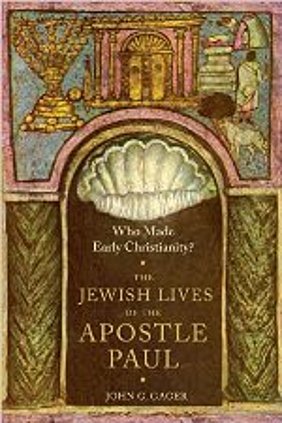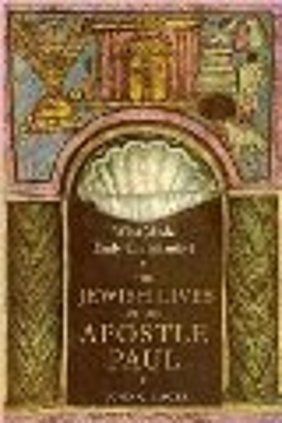Together with Lloyd Gaston and Stanley K. Stowers, John G. Gager developed the Sonderweg reading of the Pauline Epistles.[1] According to this model, Paul understood Christ to have opened up a “special path” to salvation for non-Jews distinct from the provision of salvation that was already available to Israel through the Sinai covenant. Despite its title, this book covers far more ground than ancient and modern Jewish interpretations of the Pauline corpus. It also explores the active participation of Diaspora Jewish populations in the civic life of Mediterranean societies and the range of Jewish and Christian social interactions in antiquity.
In the introduction, Gager emphasizes that the rhetoric of Christian triumphalism was part of an effort by elite theologians to forge a distinctive Christian identity and to sharply differentiate Christian beliefs and praxis from Jewish ones. He explains, “It is the distinctive role of those in power to stress unity and to patrol the borders” (p. 4). However, Christian laypersons were often drawn to Jewish communities and customs due to their antiquity and social standing, revealing that the socially constructed boundaries were porous on the ground level. Threatened by the existence of thriving synagogue congregations and the evident appeal that they held for many non-Jewish Christians, the Christian literati attempted to eliminate the threat through “conceptual nihilation” (p. 4). They asserted that the Christians replaced Israel and appropriated the biblical heritage from the Jews. Yet Christian scholars such as Origen, Jerome, and Augustine who upheld a supersessionistic outlook could still be influenced by Jewish experts on the biblical text or, in Augustine’s case, even allow that the Apostles Peter and Paul did not abandon their Jewish sacraments.
Chapter 1 turns to the question of whether Paul was the inventor of supersessionism. After isolating two lists of Pauline passages that characterize the notions of election and covenantal nomism in either positive or negative terms, Gager laments that the former list is generally subordinated to the latter. The affirmations of Israel’s covenant are usually judged as the residue of Paul’s former way of thinking that he was unable to discard or as unresolved contradictions within the thought processes of Paul or his later canonical editors. In contrast, Gager deems Paul’s positive statements to be foundational to his worldview and his polemics to be directed against rival Jewish teachers within the Jesus movement who insisted that non-Jewish Christ believers “Judaize” by assuming Jewish rites. Gager cites scholars who agree that Paul’s critical assertions about Torah ought to be contextualized exclusively within the debate over Gentile proselytism to “Judaism,” as well as Krister Stendahl’s preference for speaking about Paul’s prophetic “calling” rather than his “conversion” in the next chapter (p. 38), but there is little engagement with alternative interpretive options.[2] Gager does not devote space to rebutting exegetes who take specific texts as suggesting that the Torah was rendered obsolete in the new dispensation brought by Christ or that Paul did not feel obligated to maintain Jewish strictures (e.g., Romans 7:5-6; 14:14; 1 Corinthians 9:20-22; Galatians 2:19-20; 3:23-26). Nevertheless, Gager concludes the chapter by highlighting the noteworthy lecture of the German rabbi and philosopher Jacob Taubes on “Pauline Judaism.”
Chapter 2 continues to focus on the reception of Paul among Jewish interpreters and establishes that “[t]he idea of a centuries-long, unbroken chain of anti-Pauline writings among Jews just doesn’t exist” (p. 39). Gager observes that Rabbinic literature before the nineteenth century is silent on Paul while there are a few stray negative comments about him from the tenth-century Karaite Jacob al-Qirqisani. The rest of the chapter reviews a number of positive assessments of Paul as a Torah-observant Jew by Jewish intellectuals such as Profiat Duran, Jacob Emden, Pinchas Lapide, Sholem Asch, Michael Wyschogrod, Pamela Eisenbaum, and Mark Nanos. As for the select Jewish commentators (e.g., Heinrich Graetz, Joseph Klausner, Martin Buber, David Flusser, and Daniel Boyarin) who have criticized some of Paul’s aims, Gager uncovers a tension in their work regarding whether Paul is set up as an opponent of the Law or as a Jewish missionary inviting the nations to share in the blessings promised to Abraham.
Chapter 3 explores how Jewish communities flourished throughout the Mediterranean Diaspora, including Babylon, Asia Minor, Rome, and Egypt. The impressive archaeological remains of ancient synagogues in Sardis and Dura Europos, the textual and inscriptional references to non-Jewish “god-fearers” (phoboumenoi ton theon or theosebeis) participating in the synagogue, and John Chrysostom’s vituperative denunciations of Jewish practices to deter Christians from adopting them all paint the picture that non-Jews were welcome in synagogues. In the following chapter, Gager turns to the intense competition between Jews and Christians in Syria, partly evidenced by the writings of Ephrem the Syrian that exceed the vitriolic anti-Judaism of John Chrysostom and cross into anti-Semitism. It is clear that many non-Jewish onlookers were attracted to the Jewish way of life. Perhaps more controversially, Gager concludes from this evidence, along with a few polemical remarks (e.g., Matthew 23:15; Horace, Satires 1.4.142-143; Dio Cassius, History 57.18.5a) and Roman law codes banning conversion to Jewish practices, that there were “outreach efforts among Jews in the early centuries of the Common Era” (p. 62).
The “standard tale” crystalized in the book of Acts about how Jesus and Paul were co-founders of the “Christian” religion that superseded its Jewish predecessor, avers Gager, is a myth of origins. Gager searches for countervoices in antique Christian literature in chapter 4. The Gospel of Matthew (cf. 5:17-20; 23:2) and the book of Revelation (cf. 2:14, 20) are construed as advocating the necessity of obedience to the commands of Torah for all followers of Jesus. Surprisingly, Justin Martyr tolerates the presence of Torah-observant Jewish Christ followers in his otherwise supersessionistic Dialogue with Trypho the Jew (cf. chapters 46-47), a lenient position that was not replicated in the heresiological reports of Epiphanius and Jerome on Jewish sects like the Ebionites and the Nazoreans. Even so, Gager finds a more tolerant sentiment in his exegesis of a passage in the pseudo-Clementine literature (Recognitions 4.5; Homilies 8.5-7) that permits the pupils of Moses and the devotees of Jesus to co-exist.
Lastly, chapter 5 is a careful examination of the Toledot Yeshu (The Life of Jesus), a loose collection of narratives that circulated in different versions in Hebrew and Aramaic and that closely parodied the main contours of the Gospels and the historiography of the early church. The early versions of the Toledot may have been produced by students in eighth-century Babylonian academies, though some of the counternarratives to Jesus’ miraculous conception and resurrection had earlier precedents (cf. Matthew 1:18-19; 28:11-15; Justin, Dial. 108.2; Origen, Against Celsus 1.28, 32; Tertullian, On Spectacles 30.5-6). It was intended for internal Jewish consumption, particularly as refutations of Christian claims about Jesus in the face of Christians targeting them for conversion or harassment. One of the most striking elements is that Peter and Paul are portrayed as covert Jews who invented fabrications to motivate Christians to separate from the Jews and cease persecuting them. The depiction of Peter as a pseudo-Christian might be indebted to the Markan portrait of him as an ignorant and wayward disciple (cf. p. 44), but the Strasbourg manuscript, the Vienna manuscript, and the Tam u-Muad version honor Paul as well for convincing the Christians to have their own rituals and leave the Jews in peace.
Readers interested in a robust exegetical defense of Gager’s revisionist perspective of Paul should consult his previous monographs.[3] The chief value of this study, however, is its demonstration that the “Paul within Judaism” paradigm that is commanding the assent of a growing body of New Testament scholars is not solely the product of a particular sociohistorical context marked by increasing interreligious dialogue and Christian regret for the tragic history of anti-Semitism. Instead, this thesis has a venerable pedigree among several prominent Jewish interpreters in the past and present. Of course, if there is implicit criticism of Paul among certain New Testament authors, not to mention the Ebionites’ explicit caricature of Paul as an apostate from the Law (cf. Irenaeus, Against Heresies 1.26.2; Epiphanius, Panarion 30.16.6-9), then it is fair to admit that the image of Paul as an adversarial foil was not restricted to Jewish academics beginning in the nineteenth century. Gager’s study should also be commended for issuing the reminder that ancient Christian attitudes towards Jews and Judaism were not uniformly hostile, that there can be a recognition of difference without an accompanying demonization of the Other.



